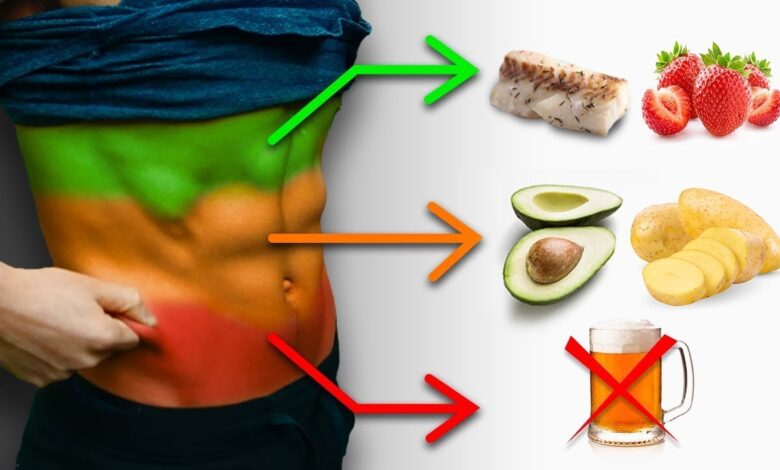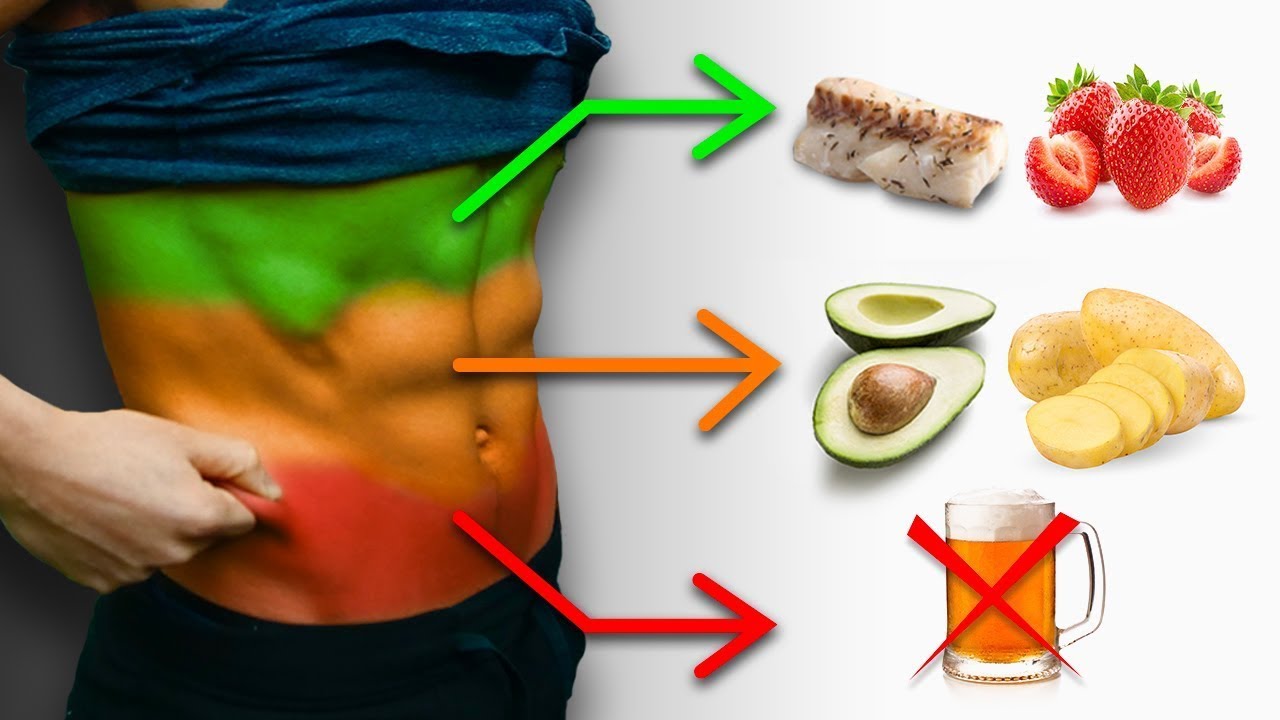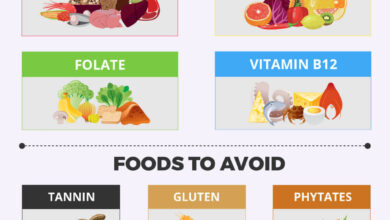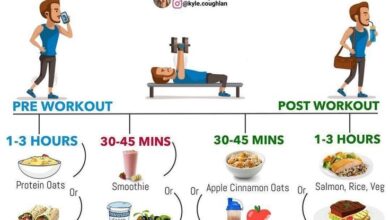
Why Losing Belly Fat Should Be Priority Number 1
Why losing belly fat should be priority number 1? It’s not just about fitting into your favorite jeans; it’s about safeguarding your health and well-being. Excess belly fat, particularly visceral fat, poses a serious threat to your heart, your blood sugar, and even your mental health.
This hidden fat deep within your abdomen can wreak havoc on your body’s systems, leading to chronic diseases and a lower quality of life.
In this blog post, we’ll delve into the science behind why belly fat is so dangerous, explore its impact on various aspects of your health, and Artikel practical strategies to help you achieve your weight loss goals.
Health Risks Associated with Belly Fat
Belly fat, also known as visceral fat, is the type of fat that accumulates around your internal organs. It’s not just an aesthetic concern; it poses significant health risks that can have a profound impact on your overall well-being.
The Connection Between Belly Fat and Chronic Diseases
Excess belly fat is closely linked to an increased risk of developing various chronic diseases. This is because visceral fat is metabolically active, releasing substances that can disrupt your body’s hormonal balance and contribute to inflammation.
Heart Disease and Stroke
Belly fat is a major risk factor for heart disease and stroke. Visceral fat releases fatty acids and inflammatory substances into the bloodstream, which can lead to plaque buildup in the arteries, increasing the risk of heart attack and stroke.
Type 2 Diabetes
Belly fat is strongly associated with insulin resistance, a condition where your body doesn’t use insulin effectively. This can lead to elevated blood sugar levels and an increased risk of developing type 2 diabetes.
Certain Cancers
Some studies have linked belly fat to an increased risk of certain cancers, including colon, breast, and endometrial cancers. The exact mechanisms are not fully understood, but inflammation and hormonal changes associated with visceral fat may play a role.
Prevalence and Health Implications of Belly Fat
Belly fat is a widespread problem. According to the Centers for Disease Control and Prevention (CDC), more than two-thirds of adults in the United States are overweight or obese. This means a significant portion of the population is at increased risk of health problems associated with belly fat.
Let’s face it, carrying extra weight around your middle can be a real drag. It’s not just about aesthetics; excess belly fat can seriously impact your health. But don’t worry, there are tons of ways to tackle this, and one of them might surprise you.
If you’re looking for a challenge that will help you shed those pounds and build incredible endurance, you might want to check out everything you need to know about ultra walking. Ultra walking is a fantastic way to burn calories and improve your overall fitness, which can contribute significantly to losing that stubborn belly fat.
So, if you’re ready to take on a new challenge and improve your health, give ultra walking a try!
Examples of Belly Fat’s Impact on Health
The negative impact of belly fat goes beyond just increasing the risk of chronic diseases. It can also:
- Lead to sleep apnea, a condition where breathing repeatedly stops and starts during sleep.
- Contribute to joint pain and osteoarthritis.
- Increase the risk of developing non-alcoholic fatty liver disease (NAFLD).
- Reduce fertility in both men and women.
Why Belly Fat is Different
While it’s true that any excess fat can be detrimental to your health, belly fat, specifically visceral fat, is a different beast altogether. It’s not just about aesthetics; visceral fat poses a unique set of health risks that warrant special attention.
Visceral Fat: The Deep-Seated Threat, Why losing belly fat should be priority number 1
Visceral fat, often referred to as deep belly fat, is the type of fat that accumulates around your internal organs, such as your liver, pancreas, and intestines. Unlike subcutaneous fat, which sits just beneath your skin, visceral fat is more metabolically active and poses a greater threat to your health.
Let’s be real, that stubborn belly fat can be a real pain (literally!). It’s not just about aesthetics, it’s about your overall health. But who says you have to give up pizza to achieve your goals? Check out this list of 11 healthy pizzas under 400 calories that can help you stay on track while still enjoying a delicious slice.
Remember, losing belly fat is a marathon, not a sprint, and finding ways to enjoy healthy foods makes the journey much more enjoyable.
Visceral Fat and Inflammation
Visceral fat cells release inflammatory chemicals called cytokines. These cytokines contribute to chronic inflammation throughout the body, which is linked to a wide range of health problems, including:
- Heart disease
- Type 2 diabetes
- Certain types of cancer
- Alzheimer’s disease
- Non-alcoholic fatty liver disease
Visceral Fat and Hormonal Imbalances
Visceral fat disrupts hormonal balance, affecting insulin sensitivity and increasing the risk of developing insulin resistance. Insulin resistance is a precursor to type 2 diabetes. Additionally, visceral fat can interfere with the production of leptin, a hormone that signals to your brain that you’re full, and increase the production of ghrelin, a hormone that stimulates appetite.
This can lead to increased hunger and difficulty managing your weight.
Health Risks: Visceral vs. Subcutaneous Fat
While subcutaneous fat can also contribute to health problems, the risks associated with visceral fat are significantly greater.
- Heart Disease:Visceral fat increases the risk of heart disease by promoting inflammation, increasing blood pressure, and contributing to unhealthy cholesterol levels.
- Type 2 Diabetes:Visceral fat is strongly linked to insulin resistance, a key factor in the development of type 2 diabetes.
- Certain Cancers:Studies have shown that visceral fat is associated with an increased risk of certain cancers, including colorectal, breast, and endometrial cancers.
The Impact of Belly Fat on Body Function
Belly fat isn’t just an aesthetic concern; it’s a serious health threat that can significantly impact your body’s function. This type of fat, known as visceral fat, sits deep within your abdomen, surrounding your organs. Its presence can disrupt various bodily processes, leading to a cascade of health problems.
The Impact of Belly Fat on Insulin Resistance and Blood Sugar Regulation
Insulin resistance is a condition where your body’s cells don’t respond properly to insulin, a hormone that regulates blood sugar levels. This can lead to a buildup of sugar in your bloodstream, increasing your risk of developing type 2 diabetes.
Visceral fat plays a crucial role in insulin resistance. It releases inflammatory substances that interfere with insulin’s ability to do its job.
- When you consume food, your pancreas releases insulin to help your cells absorb glucose from your bloodstream.
- Excess visceral fat disrupts this process, causing your cells to become less responsive to insulin.
- This leads to a buildup of glucose in your blood, potentially leading to type 2 diabetes.
The Role of Belly Fat in Increasing the Risk of Sleep Apnea and Other Sleep Disorders
Sleep apnea is a condition where breathing repeatedly stops and starts during sleep. This can lead to fatigue, daytime sleepiness, and other health problems. Visceral fat is a significant contributor to sleep apnea, particularly in men.
- The extra fat around the abdomen can compress the airways, making it difficult to breathe during sleep.
- This can lead to snoring, gasping for air, and frequent awakenings throughout the night.
- Sleep apnea can further increase your risk of heart disease, stroke, and other health problems.
The Impact of Belly Fat on Fertility and Reproductive Health
Excess belly fat can negatively impact both male and female fertility.
- In men, visceral fat can lower testosterone levels and reduce sperm quality.
- In women, it can disrupt ovulation and increase the risk of polycystic ovary syndrome (PCOS).
- Furthermore, belly fat can contribute to hormonal imbalances, affecting both men and women.
Belly Fat and Mental Health

The link between belly fat and mental health is increasingly becoming a topic of discussion. While it might seem surprising, studies have shown that excessive belly fat can negatively impact mental well-being, leading to an increased risk of depression and anxiety.
The Link Between Belly Fat and Depression and Anxiety
A growing body of research suggests a strong correlation between abdominal obesity and mental health issues. Several factors contribute to this link:
- Inflammation:Excess belly fat triggers chronic inflammation throughout the body, including the brain. This inflammation can disrupt the delicate balance of neurotransmitters, leading to mood swings, irritability, and increased susceptibility to depression and anxiety.
- Hormonal Imbalances:Belly fat can disrupt the production and regulation of hormones like cortisol, which is known as the “stress hormone.” Elevated cortisol levels can contribute to feelings of anxiety, fatigue, and difficulty concentrating, all of which can exacerbate mental health conditions.
- Sleep Disruption:Obesity, especially abdominal obesity, is often associated with sleep apnea, a condition where breathing repeatedly stops and starts during sleep. Sleep apnea can lead to poor sleep quality, which in turn can contribute to feelings of fatigue, irritability, and increased risk of depression.
The Impact of Belly Fat on Self-Esteem and Body Image
Beyond its direct impact on mental health, belly fat can also significantly affect self-esteem and body image.
- Negative Self-Perception:Society often associates a slim physique with attractiveness and health, leading many people with excess belly fat to feel self-conscious and dissatisfied with their appearance. This can contribute to feelings of low self-worth and inadequacy.
- Social Stigma:Individuals with visible belly fat may experience social stigma and discrimination, which can further damage their self-esteem and make them feel isolated and excluded.
- Body Image Issues:Excess belly fat can lead to body image issues, where individuals become overly preoccupied with their weight and appearance, often engaging in unhealthy behaviors like restrictive dieting or excessive exercise.
Positive Impacts of Reducing Belly Fat on Mental Well-being
The good news is that reducing belly fat can have a positive impact on mental well-being.
- Improved Mood and Energy Levels:Reducing belly fat can help to decrease inflammation, regulate hormones, and improve sleep quality, all of which can contribute to a more positive mood and increased energy levels.
- Increased Confidence and Self-Esteem:Achieving a healthier weight and body composition can boost self-confidence and improve body image, leading to a more positive self-perception.
- Reduced Risk of Mental Health Issues:By addressing the underlying health issues associated with belly fat, individuals can reduce their risk of developing depression, anxiety, and other mental health problems.
Strategies for Losing Belly Fat
Losing belly fat requires a multifaceted approach that combines diet modifications, exercise routines, and lifestyle changes. It’s not a quick fix, but by adopting these strategies and making them a part of your daily life, you can achieve sustainable results and improve your overall health.
Diet Modifications
Dietary changes play a crucial role in reducing belly fat. Focus on consuming whole, unprocessed foods while limiting processed foods, sugary drinks, and unhealthy fats.
- Prioritize Whole Foods:Base your meals around fruits, vegetables, lean proteins, and whole grains. These foods are nutrient-dense and provide essential vitamins, minerals, and fiber that support satiety and overall health.
- Limit Processed Foods:Processed foods are often high in calories, unhealthy fats, added sugars, and sodium, which can contribute to belly fat accumulation. Choose whole, unprocessed foods whenever possible.
- Reduce Sugar Intake:Sugary drinks, desserts, and processed foods are major contributors to belly fat. Limit your intake of added sugars and opt for naturally sweet options like fruits.
- Control Portion Sizes:Be mindful of your portion sizes and avoid overeating. Using smaller plates, measuring food, and eating slowly can help you control your calorie intake.
- Stay Hydrated:Drinking plenty of water throughout the day can help you feel full, reducing the urge to overeat. Water also aids in digestion and helps flush out toxins.
Sample Weekly Meal Plan
Here’s a sample weekly meal plan that emphasizes whole foods and portion control. It’s important to note that this is just a guide, and you can adjust it based on your individual dietary needs and preferences. Monday
Breakfast Oatmeal with berries and nuts
Lunch Salad with grilled chicken or fish and a side of quinoa
Dinner Salmon with roasted vegetables Tuesday
Breakfast Greek yogurt with fruit and granola
Lunch Leftover salmon with roasted vegetables
Dinner Chicken stir-fry with brown rice Wednesday
Breakfast Scrambled eggs with whole-wheat toast
Lunch Lentil soup with a side of whole-wheat bread
Dinner Vegetarian chili with cornbread Thursday
Breakfast Smoothie with fruit, spinach, and protein powder
Lunch Tuna salad sandwich on whole-wheat bread
Dinner Turkey burgers on whole-wheat buns with a side of sweet potato fries Friday
Breakfast Pancakes with fruit and syrup
Lunch Leftover vegetarian chili with cornbread
Dinner Pizza with whole-wheat crust, vegetables, and lean protein Saturday
Breakfast Waffles with fruit and whipped cream
Lunch Chicken Caesar salad with whole-wheat croutons
Dinner Pasta with marinara sauce and meatballs Sunday
Breakfast Eggs Benedict with whole-wheat English muffins
Lunch Leftover pasta with marinara sauce and meatballs
Dinner Roast chicken with mashed potatoes and gravy
Exercise Routines
Regular exercise is crucial for reducing belly fat and improving overall health. Aim for at least 150 minutes of moderate-intensity aerobic activity or 75 minutes of vigorous-intensity aerobic activity per week, along with strength training exercises twice a week.
Sample Workout Routine
This sample workout routine combines cardio, strength training, and core exercises. You can adjust the intensity and duration based on your fitness level. Monday:Cardio (30 minutes)
Brisk walking, jogging, cycling, or swimming
Tuesday:Strength training (45 minutes)
Squats, lunges, push-ups, pull-ups, rows, and planks
Wednesday:Rest or light cardio (30 minutes)
Yoga, Pilates, or walking
Let’s be real, shedding that stubborn belly fat is a top priority for most of us. It’s not just about fitting into those skinny jeans, it’s about overall health and well-being. But what about those carb cravings? Can we still enjoy pasta without derailing our goals?
Well, the answer is a bit nuanced, and it all comes down to the type of pasta you choose and how you prepare it. To learn more about making pasta a part of a healthy lifestyle, check out this article on can pasta be healthy.
Remember, even with pasta, moderation is key, and focusing on losing belly fat will ultimately benefit your health in the long run.
Thursday:Strength training (45 minutes)
Focus on different muscle groups than Tuesday
Friday:Cardio (30 minutes)
Choose a different activity than Monday
Saturday:Rest or active recovery (30 minutes)
Stretching, walking, or light yoga
Sunday:Rest or active recovery (30 minutes)
Choose an activity you enjoy
Core Exercises
Core exercises are essential for strengthening the muscles in your abdomen and back, which can help improve posture and reduce belly fat. Here are some examples:
- Plank:Engage your core and hold a plank position for 30-60 seconds, repeating for 3-5 sets.
- Crunches:Lie on your back with your knees bent and feet flat on the floor. Curl your upper body towards your knees, keeping your core engaged. Repeat for 10-15 repetitions, completing 3-5 sets.
- Russian Twists:Sit on the floor with your knees bent and feet flat on the floor. Lean back slightly and twist your torso from side to side, keeping your core engaged. Repeat for 10-15 repetitions, completing 3-5 sets.
- Bicycle Crunches:Lie on your back with your knees bent and feet flat on the floor. Bring one knee towards your chest while simultaneously twisting your torso to touch the opposite elbow to your knee. Repeat on the other side, alternating for 10-15 repetitions, completing 3-5 sets.
Lifestyle Changes
Beyond diet and exercise, lifestyle changes can significantly impact your belly fat reduction journey.
- Get Enough Sleep:Aim for 7-8 hours of quality sleep per night. Lack of sleep can disrupt hormone balance and increase belly fat storage.
- Manage Stress:Chronic stress can lead to increased cortisol levels, which can contribute to belly fat accumulation. Find healthy ways to manage stress, such as exercise, meditation, or spending time in nature.
- Limit Alcohol Consumption:Excessive alcohol consumption can contribute to belly fat accumulation. If you choose to drink alcohol, do so in moderation.
- Quit Smoking:Smoking increases the risk of belly fat accumulation and other health problems. Quitting smoking can improve your overall health and reduce your risk of developing chronic diseases.
The Importance of Consistency
Losing belly fat is not a sprint; it’s a marathon. Quick fixes and crash diets might offer temporary results, but they often lead to weight regain and can be detrimental to your health. The key to sustainable belly fat reduction lies in adopting consistent lifestyle changes that you can maintain over the long term.
Consistency is crucial because it allows your body to adapt to the new changes gradually. When you consistently eat healthy foods, engage in regular exercise, and manage stress effectively, your body begins to reprogram itself for optimal health and weight management.
This process takes time, but the rewards are well worth the effort.
Challenges of Maintaining Weight Loss
Maintaining weight loss can be challenging, especially in a world filled with tempting foods and busy schedules. Many factors can derail your efforts, including:
- Plateaus:Weight loss plateaus are common and can be discouraging. When your body adapts to your new lifestyle, it may require you to make further adjustments to continue losing weight.
- Stress and Emotional Eating:Stress can trigger cravings for unhealthy foods, leading to overeating and weight gain.
- Social Events and Temptations:Parties, holidays, and social gatherings can make it difficult to stick to your healthy eating plan.
- Lack of Sleep:Sleep deprivation can disrupt hormones that regulate hunger and satiety, leading to increased appetite and cravings.
Strategies for Overcoming Challenges
While maintaining weight loss can be challenging, it is not impossible. Here are some strategies to help you stay on track:
- Set Realistic Goals:Aim for gradual and sustainable weight loss, rather than trying to lose a large amount of weight quickly. A healthy rate of weight loss is 1-2 pounds per week.
- Find Support:Surround yourself with supportive friends, family, or a weight loss group. Having a support system can help you stay motivated and accountable.
- Track Your Progress:Keep a food diary or use a fitness tracker to monitor your calorie intake, exercise, and weight loss. This can help you identify patterns and areas for improvement.
- Develop Healthy Coping Mechanisms:Find healthy ways to manage stress, such as exercise, yoga, meditation, or spending time in nature.
- Reward Yourself:Celebrate your successes along the way, but make sure your rewards are non-food related. This can help you stay motivated and prevent you from sabotaging your progress.
Motivational Tips and Success Stories
Here are some motivational tips and success stories to inspire you on your journey to reduce belly fat:
“The only way to do great work is to love what you do. If you haven’t found it yet, keep looking. Don’t settle.”
Steve Jobs
Many individuals have successfully reduced belly fat through consistent lifestyle changes. For example, a recent study published in the Journal of the American Medical Association found that individuals who participated in a 12-week weight loss program that included regular exercise and a healthy diet lost an average of 10 pounds of belly fat.
Remember, it’s not about being perfect, it’s about making consistent progress. Every small step you take towards a healthier lifestyle is a victory. Embrace the journey, celebrate your successes, and don’t give up on your goals.
Last Recap: Why Losing Belly Fat Should Be Priority Number 1
Remember, losing belly fat is a journey, not a race. It’s about making sustainable lifestyle changes that you can maintain over time. Focus on nourishing your body with wholesome foods, incorporating regular exercise into your routine, and prioritizing stress management.
By taking control of your belly fat, you’re taking control of your health and unlocking a brighter, healthier future.






